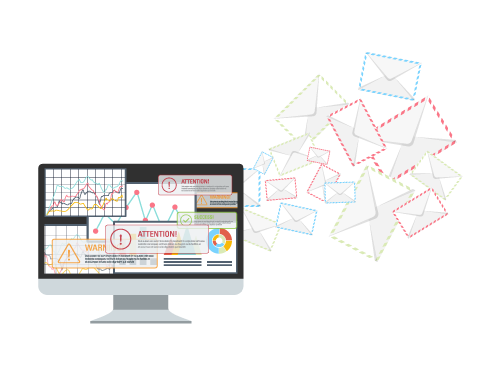
Free up staff to focus on more important tasks.

Automate responses to recurring or informational messages.

Escalate critical messages and respond quickly from your favorite device.
The Dangers of Manual Message and Event Monitoring

Any time an event happens on your system or in one of your applications, it generates a message that contains information more or less describing what has occurred. Sometimes the information is purely nice to know. Other times, it might indicate that you need to take action in order for processing to continue or to get system or application performance back to normal.
These messages can be sent to a kind of log called a message queue. Some message queues are built into the individual applications you may be running. Others like QSYSOPR or QSYSMSG are objects that you can create on the IBM i operating system to consolidate application and system messages into a central location.
Funneling your messages into a central location is all well and good, but now hundreds—more likely thousands!—of messages are flooding in with information about your business-critical applications, system resources, performance statuses, events, and even network components. How can you possibly filter through the noise to find the handful of urgent messages that actually need your attention?
You might be so overwhelmed by all the messages in your message queues that you’re operating in a completely reactive mode. You wait for end users to call with complaints about slow system performance, missing reports, or unavailable applications. When you can get away from the phone, you try manually looking for messages, but only infrequently.
You could also be checking components by running a query or command, keeping an eye out for a string of text, a status, or something that is suspiciously absent. Since it’s hard to know what you’re looking for—especially if it’s not there—you rely on runbooks, cheat sheets, and the tribal knowledge of staff with more experience.
Realizing how important monitoring is for keeping your applications available and ensuring that the environment where they run is healthy, you might have even cobbled together a kludgy series of CL commands, RPG programs, SQL statements, or Qshell scripts to relieve some of the burden. Unfortunately, this won’t keep you current with monitoring tools available in the operating system or the latest and greatest Java or web applications running on the system.
We’re able to do more important work than just looking around the system and typing commands all day long.
Ed Guevara, Senior IT Manager, Staples
Why Organizations Need Message and Event Monitoring
Depending on your industry, failure to effectively monitor messages and events can result in delayed processing for web orders or electronic fund transfers, missed point-of-sale transactions, the inability to transmit shipping information to customers or vendors, no data to feed your website, or services (like ATMs) being unavailable to end users.
It’s safe to say that without monitoring, your business’s ability to do business could grind to a halt. And fast. You need to have visibility into all potential problem areas and time to respond to issues before they get serious. With an automated message and event monitoring solution, you can monitor, filter, escalate, and even respond to critical messages automatically so you don’t lose out on any business opportunities.
Automatically Monitor, Filter, Escalate, and Notify
The Robot Console message and event monitoring solution available from Fortra makes it easy for you to stop firefighting and start managing by exception.
A Guide to IBM i Message Management
READ MORE
Robot Console Solves Message and Event Monitoring Problems
Robot Console is message and event monitoring software for the IBM i operating system. Robot Console filters incoming messages, monitors resources and system logs, and notifies an operator only when it can’t handle a situation automatically.